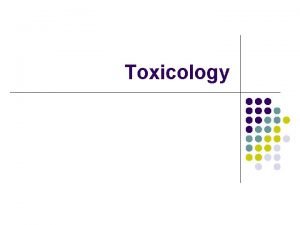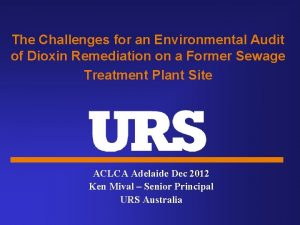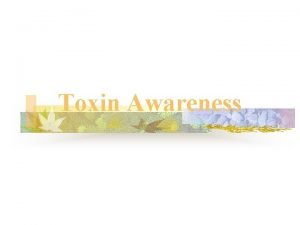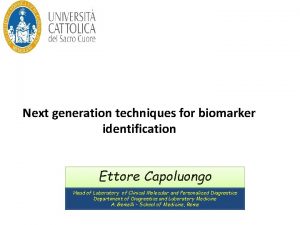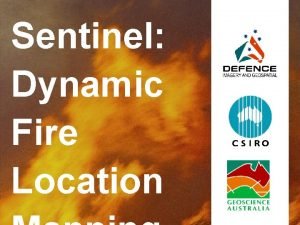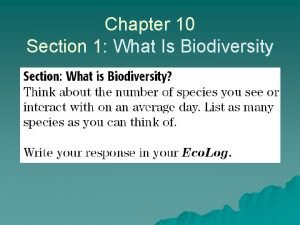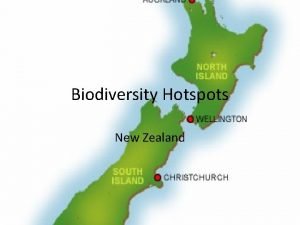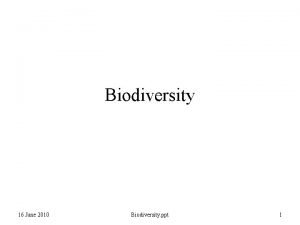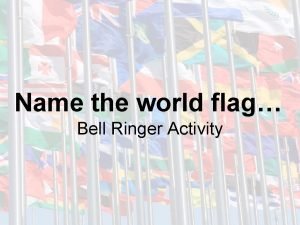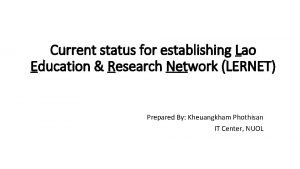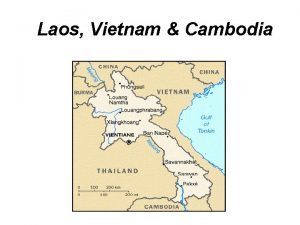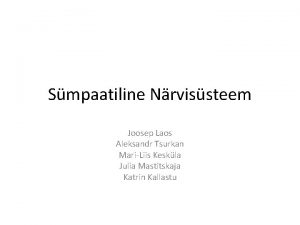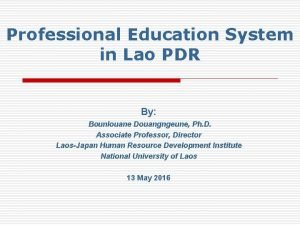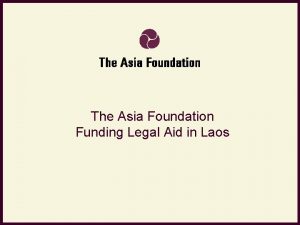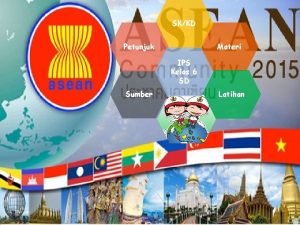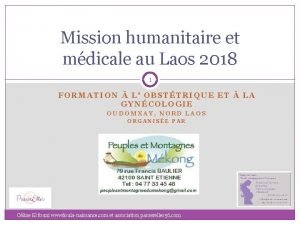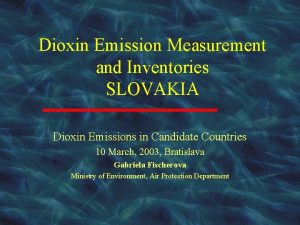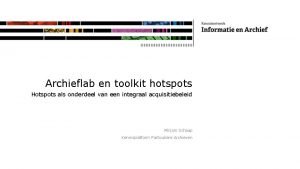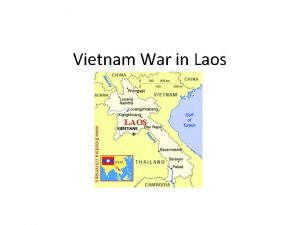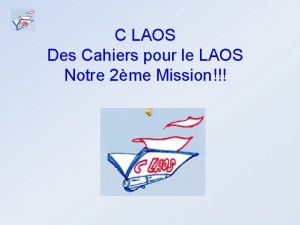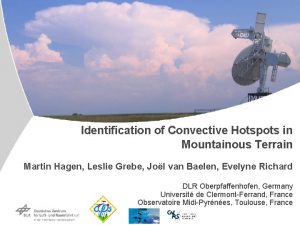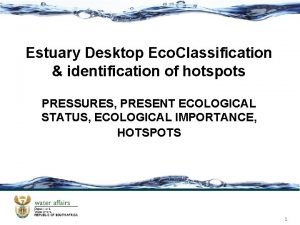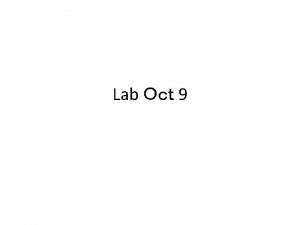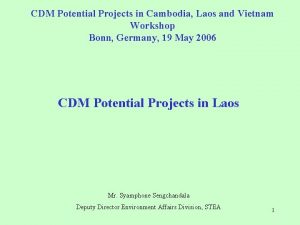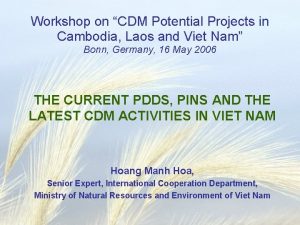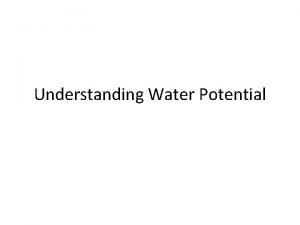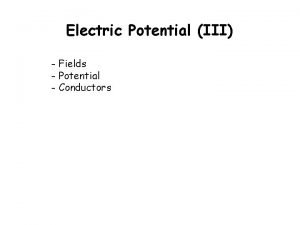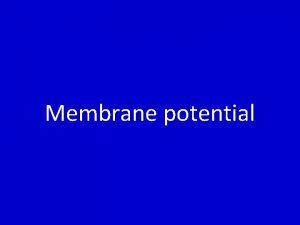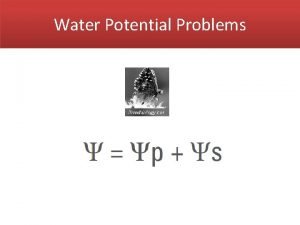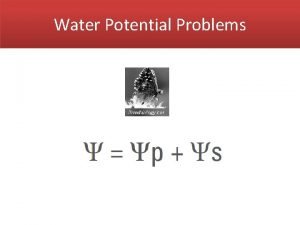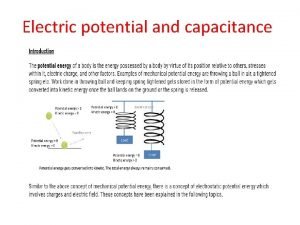IDENTIFICATION OF POTENTIAL DIOXIN HOTSPOTS IN LAOS WITH



































- Slides: 35

IDENTIFICATION OF POTENTIAL DIOXIN HOTSPOTS IN LAOS, WITH COMPARISONS TO VIETNAM Susan Hammond August 22, 2017 Dioxin 2017, Vancouver, Canada

Objectives of Agent Orange work in Laos § Assess relative exposure risks at sites in Lao PDR that are potentially hazardous as a result of Agent Orange use and handling (Hatfield Consultants/MONRE/War Legacies Project) § Survey the population currently living in heavily sprayed regions or potential dioxin hotspots to determine if there is an exposure risk and health impacts (War Legacies Project /Hatfield Consultants/Green Cross International) © Hatfield Consultants. All Rights Reserved. 2

US “Secret War” in Laos › US focus during the war in Laos was to interrupt supply along the Ho Chi Minh Trail › US also supported the Royal Lao government in their fight against the Pathet Lao › The US effort in Laos was a CIA operation › Much of the CIA operation is still classified › Air Operation conducted by CIA owned airlines © Hatfield Consultants. All Rights Reserved. 3

© Hatfield Consultants. All Rights Reserved. › Nearly 500 “Lima” sites (L, LS and PS sites) in Lao PDR were used by the US for in-country operations › 58 L Sites had runways capable of landing cargo planes and jets. › 450 were LS sites for STOL (short take off and landing) or drop zones. › Trail watching/listening station were scattered along the HCM Trail › Radar sites to facilitate bombing of Vietnam and Laos were also throughout the country 4

US Air Force Operations in Laos © Hatfield Consultants. All Rights Reserved. • Intensive US aerial bombing missions conducted over Lao PDR from 19631973 • Operation Ranch Hand 1965 – 1971 • Agent Orange (61% of herbicides) – used to destroy forest cover and food crops • 1. 6 million Liters of herbicide were sprayed over 66, 000 hectares of the HCM Trail region. • Spray runs were flown from bases in Da Nang and Bien Hoa, Vietnam and from US bases in Thailand • Spraying by Air America also occurred for a limited time in the north but the extent is unknown 5

The issue today: • • Elevated levels of dioxins (2, 3, 7, 8 -TCDD) are well documented in the environment in and around former US military sites in Vietnam It is unclear how much if any perimeter spraying was conducted at US bases in Laos It is still not known which bases controlled by the US stored herbicides A full assessment of the potential impacts of Agent Orange in Lao PDR has not been conducted. Long Tieng Airbase, Laos © Hatfield Consultants. All Rights Reserved. 6

Development in the GMS Major developments: • Hydropower in Upper and Lower Mekong River: mainstream and tributaries • Mining • Forestry and plantation • Irrigation and water diversions • Infrastructure, including powerlines, roads, and railway • UXO is a major factor affecting economic development • Significant environmental and social risks for developers to manage © Hatfield Consultants. All Rights Reserved. 7

Ho Chi Minh Trail Today: New roads are being built along the old Ho Chi Minh Trail improving access to villages for development. The roads also provide villagers access to district and provincial centers. © Hatfield Consultants. All Rights Reserved. Previously difficult to reach regions along the sprayed and bombed regions of the Ho Chi Minh Trail are being opened up for development. 8

Research on Agent Orange in Lao PDR: › Limited studies on potential Agent Orange / dioxin contamination › Lacking systematic assessment of relative risks › Little knowledge among Lao government officials at national, provincial and local level of potential impacts of dioxin contamination in Laos › Increased interest in Lao PDR following mitigation in Vietnam › Sensitive issue: – Tourism – International relations – Human health © Hatfield Consultants. All Rights Reserved. 9

Overall Approach › Review current data and knowledge › Investigation at US National Archives › Develop systematic national screening model › Implement detailed investigation at one site › Evaluate and define next steps with end-users © Hatfield Consultants. All Rights Reserved. 10

Contaminated Site Prioritization and Site Investigation National level screening: › Develop and test a methodology to screen sites with potential dioxin contamination Site-specific evaluation: › Develop and test EO products for integration into human health risk assessment at a demonstration site © Hatfield Consultants. All Rights Reserved. 11

Site Screening Approach › Site prioritization for detailed risk assessment › Ranking of sites based on objective metrics © Hatfield Consultants. All Rights Reserved. 12

Hazard Modelling › Screening exposure factors: – Percent human disturbed land cover within 5 km buffer – Average population density of all villages within 30 km of the hazard site; – Distance to closest village – Elevation difference between hazard site and closest village – Distance to closest road – Distance to closest foot road – Distance to closest stream › Z-score was calculated to normalize each site › Sum of Z-scores used to rank potential exposure as a measure of risk © Hatfield Consultants. All Rights Reserved. 13

Historic “Lima” Sites › › © Hatfield Consultants. All Rights Reserved. Various runway lengths and quality – “L” and “LS” sites; Range of topographic settings Various amount of time under US or Royal Lao government control Range of populations in the tens of thousands (Long Tieng LS 20 A to relatively unpopulated drop zones 14

Potential hotspots › Occupied by US or Royal Lao forces between the end of 1965 and early 1971. › Heavily vegetated to warrant the use of defoliant, which would be especially likely in areas difficult to clear manually (e. g. high mountain top sites). › Bases that were of particular strategic importance, such as TACAN radar sites, military headquarters or refugee camps › Supply depots for other landing zones or bases would have a higher likelihood of being sprayed. © Hatfield Consultants. All Rights Reserved. 15

Using these criteria, the long list of in-country military sites was refined to create the short list of 27 sites for more in-depth site prioritization for risk assessment. Air America base, Wattay Airport, Vientiane © Hatfield Consultants. All Rights Reserved. Rank Site 1 Wattay/Vientiane (LS-8) 2 Relative Rank Site 6. 65 15 Na Khang (LS-36) Pakse (L-11) 5. 76 16 3 Attapeu (L-10) 4. 92 17 Thoung Leg Airfield -0. 18 4 Luang Prabang (L-54) 4. 20 18 Xieng Lom (LS-69) (LS-274) -0. 42 Risk Long Tieng (LS-20 A, LS-30, LS‑ 98) Ban San Thong/Sam Thong Risk 0. 08 -0. 07 5 Xieng Khoang North (L 22) 3. 95 19 6 Ban Huoeisay (L-25) 3. 70 20 Pha Khao (LS-14) -1. 15 7 Savannankhet (L-39) 3. 46 21 Bouam Long (LS-32) -1. 16 8 Muong Hiem (LS-48 A) 3. 22 22 Nam Lieu (LS-118 A) -1. 44 9 Muong Cha (LS-113) 2. 80 23 Ba Na (LS-15) -2. 99 10 Muong Soui (L 108) 2. 32 24 Ban Nam Thouei (LS-118) -3. 57 11 The Bra (SOG Site) 2. 18 25 The Golf Course (SOG) -4. 78 12 Hotel 9 (SOG Site) 2. 08 26 Leghorn (SOG Site) -6. 20 13 Ban Son/Xon (LS-246) 2. 00 27 Pa Doung (LS-5) -7. 16 14 Javan (Chavan) Army base 1. 49 (LS‑ 20) -0. 53 16

Screening and Risk Ranking Results © Hatfield Consultants. All Rights Reserved. 17

Site-specific Investigation Approach › Human health risk assessment – – Problem Formulation Effects Assessment Exposure assessment Risk estimation › Chemical Hazard: one or more chemical contaminants at concentrations capable of causing human health or ecological impacts; › Receptors: humans, animals or plants at the site; › Pathway: a way for chemical contaminants to reach the receptors © Hatfield Consultants. All Rights Reserved. 18

Site-specific Investigation Approach › Chemical hazard – Hatfield (2005) laboratory results indicated high TCDD levels (37. 8 to 31. 5 pg/g) and high percent contribution to total toxicity (TEQ-97 to 84%) – Hiyoshi (2008) laboratory results (using CALUX bio-essay) identified site as contaminated area. – Reports of Agent Orange barrels stored at this site › Receptors – EO used to define land use (buildings and aquaculture ponds) using high resolution images – Socio-economic data Discussion with Village Head regarding site history and potential exposure pathways © Hatfield Consultants. All Rights Reserved. 19

Site-specific Investigation Location › Dak Triem area incorporating the “Javan Military Site” in Dak Cheung District, Sekong Province › One of the poorest districts of Sekong Province › Village (including households and school) in close proximity to the site › Aquaculture ponds below (downstream) of the site › Bare ground and exposed soil (dust problem) © Hatfield Consultants. All Rights Reserved. 20

Preliminary Quantitative Risk Assessment › Screening level - estimates of individual variables will be approximate › Availability of high quality images and GIS analysis support the risk assessment – Hazard sources, pathways and receptors can be quickly discerned, and their proximity evaluated – Proximity of buildings, schools and other land use – Exposed soils identified from Rapid. Eye – Water surface flow directions are calculated from topographic information © Hatfield Consultants. All Rights Reserved. 21

Risk Investigation Composite © Hatfield Consultants. All Rights Reserved. 22

Evaluation National screening › Methodology can systematically remove sites unlikely to have contamination › Ranking methodology extends standard approaches › Site Screening Profiles provide a standardized snapshot of each potential hazard site Site-specific risk assessment › Detailed maps support risk assessment and logistics and situational awareness › Improved elevation data required for drainage assessment › Hatfield also offers full contaminated site investigation, sampling and monitoring services © Hatfield Consultants. All Rights Reserved. 23

WLP’s Laos Agent Orange Laos Survey › Identify ongoing health and environmental impacts of Agent Orange Dioxin in heavily sprayed regions of Laos and potential hotspots. › Provide direct support services to those who have illnesses/disabilities that may related to exposure to Agent Orange/Dioxin or other persistent organic pollutants. › To raise worldwide awareness about the impacts of Agent Orange/Dioxin in the Lao PDR © Hatfield Consultants. All Rights Reserved. 24

The heavily sprayed and bombed regions of southern Laos are still the poorest region in the country © Hatfield Consultants. All Rights Reserved. 25

Unlike in Vietnam: › Little understanding of the use of herbicides during the war › Little understanding about potential on-going health and environmental impacts of Agent Orange/Dioxin. › No Lao government programs to address Agent Orange/Dioxin › Little data gathered on the status of health/disabilities in sprayed regions › Few studies of environmental impacts such as dioxin hotspots, soil degradation and erosion, habitat destruction or loss of valuable or culturally important trees and vegetation. © Hatfield Consultants. All Rights Reserved. 26

Focus Villages › Utilized HERBS spray records and the 2005 Lao DECIDE census data › 200 Villages today are within 10 km of the spray routes of Khamoune, Savannakhet, Salavan, Xekong and Attepeu Provinces. © Hatfield Consultants. All Rights Reserved. 27

Priority Areas › Villages populated during the years of spraying or that relocated within a 10 km radius of the spraying › Villages are somewhat assessable using four-wheel drive vehicles or less than 5 km walk from an accessible road. › This left 126 villages in Samoi and Taoey in Salavan and Nong, Sepone and Villabouly in Savannakhet › © Hatfield Consultants. All Rights Reserved. 28

Salavan Province: Taoey and Samoi Districts © Hatfield Consultants. All Rights Reserved. 29

› Interviews with elders in 36 of these villages between 20142017 indicate that recollection of spraying was consistent with the spray records. › Some villagers also recalled bombing and use of napalm. › Elders recollections were also consistent with the impact of the defoliants on forest cover. © Hatfield Consultants. All Rights Reserved. 30

In-Depth Village Survey › Determine situation of the village before, during and after the war › Identify birth defects consistent with the VA’s lists › Interview at least 5 women of varying ages about their reproductive history. › Observe heavily defoliated mountainsides, note barrels, bomb crates and areas that might be collection points for dioxin. › Develop a list of those who will receive direct services © Hatfield Consultants. All Rights Reserved. 31

Birth Defects recognized by VA for female veterans Achondroplasia Cleft lip and cleft palate Congenital heart disease Congenital talipes equinovarus (clubfoot) Esophageal and intestinal atresia Hallerman-Streiff syndrome Hip dysplasia Hirschprung's disease Hydrocephalus due to aqueductal stenosis Hypospadias Imperforate anus Neural tube defects Poland syndrome Pyloric stenosis Syndactyly (fused digits) Tracheoesophageal fistula Undescended testicle Williams syndrome Spina Bifida (only birth defect recognized for male veterans) Bold are Conditions identified in LAOS survey © Hatfield Consultants. All Rights Reserved. 32

Survey Results: Some patterns: › › › › Elders report that they were more well off before the war Malnutrition, poor health care, and non-existent pre-natal care common to most of the villages. More remote villages are worse off. We do not see the same severity of disabilities in Laos as we do in Vietnam. Most birth defects found to date are in the form of limb and spinal deformities. Cleft palate/lip is also found frequently In some cases villages that were more heavily sprayed have large numbers of people with birth defects It is not at all possible to determine if any of the birth defects found are related to war time spraying of dioxin contaminated herbicides Many of the heavily sprayed villages have large numbers of bomb craters that are used for fishing ponds that may require further analysis. © Hatfield Consultants. All Rights Reserved. 33

Future work › WLP will continue to survey remaining 90 villages 20172020 › Engage the US Government regarding the need for an Agent Orange assessment in Lao PDR › Continue to get information on possible dioxin hotspots (i. e. Ranch Hand plane crash site, Long Tieng) › Continue to work to provide direct assistance to poor disabled in heavily sprayed areas © Hatfield Consultants. All Rights Reserved. 34

Kop Chai Lai / Thank You Susan Hammond War Legacies Project Chester, VT shammond@warlegacies. org Thomas Boivin Enterprises Inc. North Vancouver, Canada tgboivin@gmail. com Andy Dean Hatfield Consultants Partnership North Vancouver, Canada adean@hatfieldgroup. com © Hatfield Consultants. All Rights Reserved. 35
 Dioxin poison
Dioxin poison Dioxin poisoning
Dioxin poisoning Dioxin poisoning
Dioxin poisoning Mariana trench
Mariana trench Definition of biodiversity hotspot
Definition of biodiversity hotspot Indo burma region
Indo burma region Sentinel fire hotspots
Sentinel fire hotspots Us biodiversity hotspots
Us biodiversity hotspots New zealand hotspot
New zealand hotspot What is biodiversity ppt
What is biodiversity ppt Name
Name Laos official language
Laos official language Laos name
Laos name Joosep laos
Joosep laos Laos literature
Laos literature Education system in laos
Education system in laos Asia foundation laos
Asia foundation laos Maarja laos
Maarja laos Negara laos beribukota di
Negara laos beribukota di Humanitaire laos
Humanitaire laos Central pocket vs plain whorl
Central pocket vs plain whorl ψs
ψs Unit of electric potential
Unit of electric potential Source of bioelectric potential
Source of bioelectric potential Difference between action and graded potential
Difference between action and graded potential Pe=qed
Pe=qed Action potential resting potential
Action potential resting potential Graded potential vs action potential
Graded potential vs action potential Electric potential and potential difference
Electric potential and potential difference End-plate potential vs action potential
End-plate potential vs action potential Saltatory conduction
Saltatory conduction Flaccid cell
Flaccid cell Electric potential
Electric potential Sales potential vs market potential
Sales potential vs market potential Nerve action potential
Nerve action potential Electric potential difference
Electric potential difference
